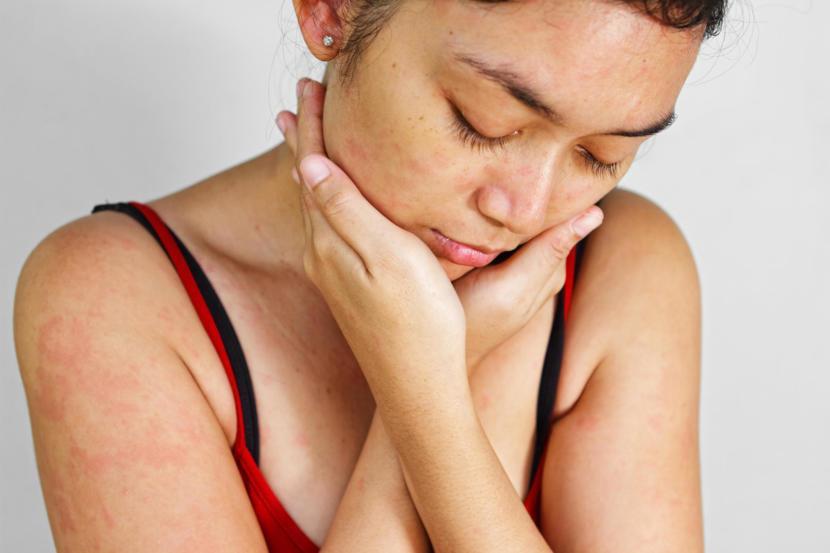What Is Molluscum Contagiosum?

Molloscum contagiosum is a viral infection that presents wart-like bumps or small growths on the skin. Usually, these growths are pink, white, or skin-colored. They are smooth, shiny, and pearly looking. The center of these growths is indented like a dimple.
This infection is very common among kids between 1 and 12 years old. But usually it affects wrestlers and athletes who have skin-to-skin contact, and people with weakened immune system (such as people with cancer or HIV). It's also contagious.
From exposure to symptom appearance, the average time is about 2-7 weeks and in some people it can be as long as six months. Lesions may last for up to 1 year, although some people can have it it for years. The contagious period of the lesion depends on when they resolve and this period may vary.
Causes
This virus lives in areas where people live in close quarters and thrives in a warm, humid climate. The bacteria can enter through a small break in the surface of the skin. Usually, people have immunity against this virus and do not develop growth.
In kids, molluscum contagiosum may spread easily by skin to skin contact but even by touching infected objects such as towels and clothing, the virus may spread. Molluscum contagiosum may spread even from one part of the body to another by scratching or rubbing the growth and touching other body parts.
If the virus is passed While having sex, the first mollusca may appear on the skin of the lower abdomen and around the vagina, penis, or anus. You should also check for other sexually transmitted diseases if this occurs.
How does molluscum contagiosum develop?
After the skin has become infected with the virus, small lumps may develop on the skin 2-8 weeks later. Each lump can last a few weeks or months; then they crust over and go away. New ones tend to appear as the old ones disappear. It may take up to 18 months before it disappears completely. It may last longer than that, too.
Signs and symptoms
The only real sign or symptom is small round pink, white, skin colored mollusca on the skin. Initially it starts out as a small spot, the size of a pinhead. Over a period of several weeks, it becomes larger. An indentation is present on the top of each molluscum.
The mollusca can appear alone as a single bump or in clusters, groups, or rows. Most commonly, the mollusca can show up on the stomach, chest, legs, groin, arms, face, and genital area, or almost anywhere on the skin they can show up.
In sexually active teens and adults, the bumps are present usually in the genital area or the inner thighs. The bumps may appear around the eyes or around the mouth, but this is rare.
Usually the mollusca is painless, but they are red, itchy, sore, and swollen, and if scratched, then they may become infected.
Diagnosis
A dermatologist may likely recognize molluscum contagiosum just by looking at the rash. Based on the person’s history and physical exam, presumptive diagnosis can be done. Usually the viral infection is a definitive diagnosis and is marked by skin biopsy or tissue scrapping. At this stage, molluscum contagiosum can be differentiated from other skin problems such as genital warts, herpes, folliculitis, and hives.
Treatment
Usually in many cases it goes away on its own.
The doctor may use certain treatment options to remove the growths or to help them go away. This includes:
- To remove the contagious center, the growth is squeezed. This is done by scalpel or tweezers.
- Cryotherapy
- Curettage
- A chemical agent or creams such as tretinoin, cantharidin, salicyclic acid, podophyllin or any other wart medicine is applied
- Antiviral medicine (valtrex) can be used
- Oral medicine such as cimetidine can be used to treat molluscum contagiosum in small children
- Any symptoms accompanied with scratching the nodules can be reduced by topical desonide cream
- In some cases, the disease can be treated with topical anti inflammatory medication such as diclfenac gel
- Creams and lotions options include hydrogen peroxide, benzoyl peroxide, potassium hydroxide, and iodine preparations
- Pulsed dye laser therapy – the skin specialist will blast the mollusca with laser beams
- For itchy or infected skin around the mollusca, you can talk to your doctor to prescribe cream
Sometimes the treatment depends on the number and location of lesions.
Treatment works best when started early. You can discuss the advantages and disadvantages of treatment with your doctor.
Home remedies
For this disease, a wide range of home remedies are available. Remedies such as apple cider vinegar, alcohol, hydrogen peroxide, tea tree oil, iodine, and elderberry extract have been used, but there isn't any data to support their use. Some clinicians suggest duct tape occlusion treatment. Before trying these remedies, the patient should discuss with the doctor.
Prevention
Since molluscum contagiosum is contagious and may spread to other parts of the body, precautionary measures should be taken.
- Avoid rubbing, scratching, or touching the growths
- Wash your hands with soap and water
- Keep the affected area covered
- Change the bandage daily or whenever the bandage becomes dirty
- Areas where bumps are present should not be shaved
- Moisturize the area if dry
















